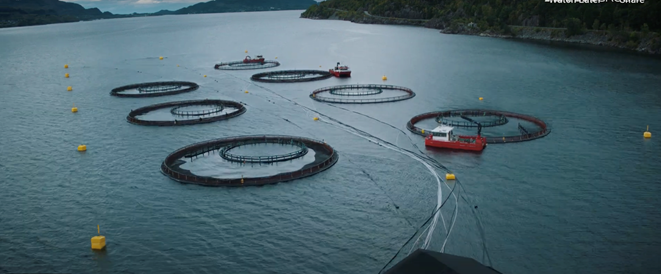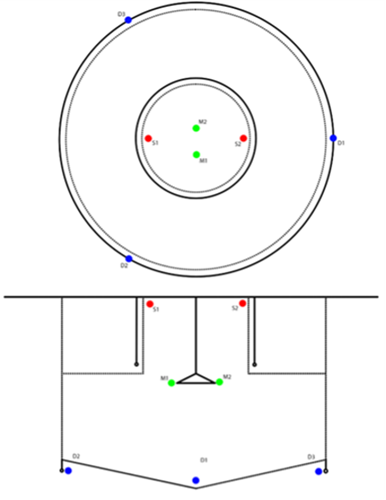Tubenet™ technology for sea lice control in Scotland (TUBENET-PROOF)
Addressing specific scientific questions to fully understand the efficacy and impacts of Tubenet™ on fish stocks and its efficacy against sea lice in Scotland.
Impact
The project was valuable for validating whether the implementation of Tubenet™ technology in Scotland could be successful, which first required testing on full-scale commercial pens to scientifically demonstrate the benefits of the concept and understand the potential impacts on salmon behaviour, performance and water quality.
£75,284
Total value
Partners
Partners
University of Stirling, Mowi Scotland, AKVA group
Project Leads
Dr Adam Brooker, Dr Herve Migaud, Donald Fowler
Case study
Download PDF
The project was initiated in November 2020 but put on hold from March 2021 due to Covid. It was terminated at the end of a six-month no-cost extension due to unforeseen Covid-related delays and production schedule. As a consequence, the project did not deliver on the objectives, although knowledge has been gained.
BACKGROUND
Sea lice continue to be a significant challenge for the salmon sector in Scotland, with impacts on fish welfare as well as productivity due to the increased costs of multiple treatments and, importantly, consumer perception towards salmon farming.
Over the years, the portfolio of pest management tools against sea lice has grown, moving away from medicinal treatments – for which resistance has been building up – to the use of physical and biological interventions. While these new methods have shown great potential and success at removing lice, they are associated with welfare concerns for salmon stocks and cleanerfish, which good husbandry practices and technology developments aim at minimising and mitigating.
It is widely acknowledged that sea lice control requires an integrated pest management strategy in which several methods are used, also including preventive measures, such as physical barriers between fish and sea lice. Innovation and development of new solutions are paramount to tackling sea lice and helping the sector improve its sustainability credentials and productivity.
One emerging new preventive method against sea lice is the use of Tubenet™ technology, which has the potential to significantly reduce sea lice infection by separating salmon and sea lice from each other. While Tubenet™ technology has been tested in Norway with promising outcomes, the bathymetry and hydrodynamics of coastal waters are different in Scotland (shallower with stronger tides and currents), and net pens are usually smaller with shallower nets. Therefore, Tubenet™ requires further development and testing for use in Scotland.
This project intended to address specific scientific questions to fully understand the efficacy and impacts of Tubenet™ on fish stocks and its efficacy against sea lice. These include understanding how the Tubenet™ technology impacts salmon behaviour, feeding, growth and overall welfare, water quality and sea lice distribution, and to optimise the deployment of such a new technology in Scottish waters for optimal efficacy.
ORIGINAL AIM
The main research aim was to study the impact of Tubenet™ technology on salmon swimming and feeding behaviour, sea lice infection, water quality, growth performances and welfare in a Scottish environment, and to test the effects of snorkel depth and water pumping in the snorkel, as well as its potential economic impacts.

From AKVA group TubenetTM installation video
Work done and proposed experimental study
The project was valuable for validating whether the implementation of Tubenet™ technology in Scotland could be successful, which first required testing on full-scale commercial pens to scientifically demonstrate the benefits of the concept and understand the potential impacts on salmon behaviour, performance and water quality.
As such, it was planned to tag and track a salmon batch living in a Tubenet™ under commercial conditions. To collect the data required, it was necessary to deploy a hydrophone array covering one circular 45m-diameter pen at the site consisting of seven hydrophones, linked through Wi-Fi to a PC located in the feed barge, and monitored remotely via a secure internet connection in real time.
The two shallow hydrophones, shown below in red, were planned to be suspended 1m below the water surface.
The two mid-water hydrophones, in green, were to be clamped to the sub-feeder, with the cables routed up the centre column of the sub-feeder to the surface.
The three deep hydrophones, in blue, were to be installed to the deep sink tube holding the main net in place with the cables routed outside the net to the surface.

Figure 1: Location of the hydrophones in the TubenetTM pen
The Acoustic Tracking Receiver (ATR) was also planned to be connected via Wi-Fi to the desktop PC for data storage and system control. Both the ATR and PC powered via uninterruptible power supplies (UPS) to ensure continuous data collection.
For tagging salmon, each acoustic tag was intended to be joined to a Floy Lock-on tag with shrink tube and epoxy adhesive for external tagging. 100 salmon were planned to be randomly netted and anaesthetised, weighed and length measured, with the Floy tag surgically implanted into the dorsal musculature.
The hydrophones were intended to record acoustic ‘pings’ emitted from the tagged fish every 5-10 seconds over a period of five months, data downloaded from the feed barge PC weekly, and raw acoustic data processed to triangulate each fish’s position and behaviour, such as swimming depth and speed, location, acceleration, heading and turn angle.
Water quality loggers were to be deployed in three pens to monitor the impact of the Tubenet™ on water quality parameters throughout the study. Three Aquameasure DOTD loggers located at 1m, 10m and 25m, and the three already at the site, would have been used to record water parameters.
Access to weekly sea lice counts and fish performance data (feeding, growth, mortality) and plankton data would have been required to correlate with salmon behaviour metrics and performance as well as larval sea lice counts.
Acoustic data analysis tools developed at the University of Stirling’s Institute of Aquaculture were meant to be used to compare salmon behaviour (depth, speed, use of snorkel, etc.) before and after changing conditions or perturbations, including natural ambient fluctuations such as daily and seasonal cycles, Tubenet™ setup, and regular commercial farm activities such as grading, harvesting, net cleaning, treatments, etc.
Regrettably, none of the acoustic/behaviour planned tasks were able to be completed and no data could be collected as a result of the unforeseen Covid delays and setbacks outlined above. Work is ongoing in Norway and if results are promising, partners may decide to revive the project and test the technology in Scotland. AKVA group is continuing with lice-free technology in Norway where the depth and lack of proximity of other sites appear to be more appropriate for this technology.
The activities that took place between November 2020 and project end encompassed the fine-tuning of the experimental design and logistic requirements, ethical and home office applications and approval, training in the new tagging procedure, meeting between partners, definition of technical requirements, purchase of acoustic tags, and calibration of hydroacoustic equipment.
As of February 2021, all technical components for the experimental study were in place. However, due to Covid restrictions, the project experienced delays in purchasing, delivery of equipment and, importantly, access to the Mowi site due to production schedule, which forced the project team to postpone the trial.
One of the main impacts of the Covid-caused delay was fish size, as the cohort had reached the last phase of the production cycle without enough time left to run the experiment properly before harvest. It was, therefore, decided to extend the project and put all activities on hold from March to restart after the summer. However, no other suitable site could be identified by the leading commercial partner, and the project was terminated.
AKVA group has continued to invest and innovate to further develop TubenetTM and other lice-excluding submerged and surface farming technologies, such as NautilusTM and OpticageTM.